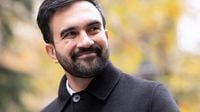New York City’s political landscape is abuzz this week as Mayor-elect Zohran Mamdani unveiled a sweeping and unusually inclusive transition plan. On November 24, 2025, Mamdani announced the appointment of more than 400 people to 17 transition committees, signaling an ambitious effort to reshape City Hall and address the city’s most pressing challenges. The move, which features a blend of traditional and novel advisory groups, reflects both the scale of expectations and the urgency of the moment as New York stands at a crossroads.
Speaking to a packed room at El Museo del Barrio in East Harlem, Mamdani wasted no time setting a new tone. “So often, what we have seen is transitions are times of pageantry and pomp,” he told those gathered. “We want to make this a period of purpose and of preparation.” According to WABC and ABC News, the committees span a vast array of issues: housing, transportation, community safety, economic development, government operations, immigrant justice, technology, and more. Notably, Mamdani is adding two new committees on worker justice and community organizing—areas not traditionally included in mayoral transitions.
The breadth of the transition team is striking. It includes homeless outreach workers, real estate developers, union leaders, community organizers, and five prominent members of the Democratic Socialists of America. The list of appointees reads like a who’s who of New York’s civic life, from veteran government officials and nonprofit leaders to private sector heavyweights. “We want to make sure that these New Yorkers who have so often been at the heart of when government has worked and also have seen it when government has failed, they can inform how we’re looking to form our next government,” Mamdani explained to reporters after the announcement, according to NY1.
This transition is not just about symbolism. The committees will help Mamdani and his leadership team make hiring and policy recommendations as they prepare to staff 60 agencies, 95 mayoral offices, and 257 boards and commissions. The numbers are staggering: as of November 24, the administration had received over 70,000 resumes, with applicants averaging just 28 years old. That’s no small feat in a city where, as Mamdani pointed out, there are currently 17,000 vacancies in government jobs—including 2,600 open NYPD positions, 2,500 teaching posts in the Department of Education, and 1,600 slots in the Correction Department.
Mamdani sees this influx of interest as evidence that the old narrative about public sector apathy no longer holds. “For a long time in New York City, we’ve been told that one of the reasons we have a shortfall—vacancies of about 17,000 people in our workforce—is because of a lack of interest,” he said. “And what we’re seeing is that is patently not the case anymore.”
The transition team’s composition also sends a clear message to Mamdani’s base. According to Professor J.C. Polanco of the University of Mt. Saint Vincent, the creation of the worker justice and community organizing committees reassures supporters—particularly those aligned with the Democratic Socialists of America—that Mamdani remains committed to the ideals that propelled his election. “If you are a card-carrying member of the DSA, you’re concerned today that maybe the guy that rose to the mayor’s position with your support is turning on you. So it’s important that he says to them, I’m still one of you, I got your back,” Polanco observed.
Transition Executive Director Elana Leopold emphasized the stakes, noting, “Excellence is the guiding light driving this transition, and today’s committee appointees are no exception. Together, these leaders will help prepare Mayor-elect Mamdani’s administration to take on the city’s toughest challenges—from housing access to emergency preparedness to the day-to-day operations of city government that must be exceptional.”
The committees themselves are a testament to the city’s diversity and complexity. The arts and culture committee features luminaries from the New York Public Library, MoMA PS1, and the Apollo Theatre. Community organizing brings together figures from the Working Families Party, Tenant Bloc, and the Muslim Democratic Club of New York. Public safety and criminal legal system committees include educators, former law enforcement, and advocates from the Legal Aid Society and Vera Institute. Even the technology committee boasts experts from the ACLU, Tech NYC, and the AI Now Institute.
Bhairavi Desai, head of the New York Taxi Workers Alliance and chair of the worker justice committee, spoke to the city’s economic realities: “In a city with tourism, service and hospitality industries worth billions, the working class—which is largely people of color and immigrants—do the work that allows rest and leisure. That labor, that dedication to excellence for our city, should be treated with respect.”
The transition’s launch comes on the heels of a much-discussed meeting between Mamdani and President Donald Trump, held at the White House on November 21. The two leaders, who had previously exchanged pointed rhetoric on the campaign trail, appeared cordial in a joint news conference after their 25-minute closed-door conversation. Both described the meeting as productive, focusing on affordability and public safety—two of the most urgent issues facing New Yorkers.
“I made the case for our city,” Mamdani told reporters. “I made the case for delivering on the foremost crisis in New Yorkers’ lives, the cost-of-living crisis. And I was heartened to hear President Trump share in the pool afterwards that he was looking to help this city, not to hurt it.” When pressed about Trump’s intentions regarding federal troops and funding, Mamdani said, “We spoke about these as commitments. And I was thankful for the productive conversation.”
Trump, for his part, signaled a shift in tone, stating on November 22, “other places need [federal troops] more” when asked if he would send them to New York. Mamdani clarified his stance, emphasizing that “the NYPD would be the ones to do so” when it comes to delivering public safety.
As the city prepares for the new administration to take office on January 1, the sense of anticipation is palpable. “A love for hard work, a deep belief in the promise of New York City, and a commitment to the affordability agenda that New Yorkers are demanding unite the more than 400 experts we have appointed to our Transition Committees today,” Mamdani said. “By helping us recruit top talent and develop smart policy, these committees will be instrumental to ensuring we hit the ground running—and that our results align with the promises we’ve made.”
With a diverse coalition of advisers, a record-breaking influx of applicants, and a focus on both tradition and innovation, Mamdani’s transition marks a pivotal moment for New York City. The coming weeks will reveal just how far this new approach can go in meeting the city’s challenges and aspirations.





